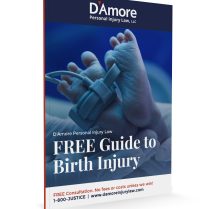D'Amore Personal Injury Law, LLC
Serious Injury Lawyers Proudly Serving
Baltimore, Annapolis, & Washington, D.C.
Hypoxic Ischemic Encephalopathy
What is Hypoxic Ischemic Encephalopathy?
Hypoxic ischemic encephalopathy (HIE), sometimes referred to as neonatal encephalopathy, perinatal asphyxia, or birth asphyxia, is a condition experienced by a baby at birth from a lack of oxygen resulting in permanent injury to the baby’s brain. There are various causes for this injury, many of which arise from negligence by the baby’s healthcare providers. In the following sections, we will provide an overview of HIE, its causes, treatments, and legal options for obtaining compensation for the negligence that caused the HIE in a child.
Clients Lives We've Helped Rebuild
Her daughter suffered a birth injury
" Fantastic Attorney "
— Kieara D.
Maternal fetal circulation and oxygen delivery to the baby
While the baby is still in the womb, the baby’s lungs are not yet functioning and the baby depends on the oxygen transferred from the mother. The mother’s blood contains oxygen and is delivered to the uterus. In the uterus, the oxygen is transferred to the placenta where the baby’s blood absorbs the oxygen and carries it to the baby via the umbilical cord. The oxygen-rich blood is then delivered to the baby’s organs and tissues via the baby’s circulatory system. The oxygen is necessary to sustain the health of the baby’s organs and tissues. Any event or condition that affects the delivery of oxygen along this pathway from the mother to the baby will affect the health of the baby. During labor, the health of the baby based on the oxygen delivered to the baby’s brain can be monitored with a fetal heart monitor. The patterns of the baby’s heart rate indicate to healthcare providers whether a baby is receiving adequate oxygen or if there are risks for brain injury from lack of oxygen.
Hypoxic Ischemic Encephalopathy Explained
The term encephalopathy refers to a brain disorder. In this case, the disorder stems from a lack of oxygen and reduced blood flow to the baby’s brain. Hypoxic ischemic encephalopathy may occur during pregnancy, delivery, or even after birth during the postnatal period. For a baby’s brain to function and survive, oxygen must be delivered to the cells of the brain. HIE may occur in premature or full-term infants. Moreover, inadequate oxygen delivery may not affect only the brain but also affect other organs such as the kidney and liver.
What Happens to Infants with HIE?
The effects of HIE vary from one child to another depending on the extent of oxygen deprivation. The longer the baby’s brain is deprived of oxygen, the more severe the injury and complications of HIE may be. The result of this injury can vary widely from temporary effects to severe and permanent injury with significant disability. For those who have permanent injuries, some may have only mild cognitive issues that don’t impede their ability to lead a normal life. Others, however, experience extreme disability and developmental delay, and some may not survive past infancy. According to Newborn and Infant Nursing Reviews, “40-60% of affected infants die by 2 years of age or have severe disabilities.” This injury is among the most severe injuries that affect full-term infants. Worldwide, HIE causes 23% of neonatal deaths. Some serious conditions associated with HIE include epilepsy, cerebral palsy, and cognitive impairment.
History and Signs Suggesting HIE
Infants that experience HIE may not initially show any signs of brain injury. Often, healthcare providers and parents will not appreciate the full extent of the injury until the child grows and develops as expected developmental milestones are not met. In other cases, HIE is immediately suspected based on the history of the birth and the baby’s condition after birth. Some of the common signs of this injury include:
Birth history
- Difficult delivery (shoulder dystocia)
- Maternal blood pressure problems during labor
- History of cord compression (cord prolapse) or cord wrapped around the baby (nuchal cord)
- Maternal bleeding (uterine rupture, placenta previa, placenta abruption)
- Non-reassuring fetal heart tracings during labor
Baby’s condition after birth
- Breathing difficulties
- Lack of reflexes (i.e. the infant may not respond to noises)
- Feeding problems
- High or low muscle tone
- Low Apgar scores
- Seizures
- Abnormal level of consciousness (the infant may not show signs of being alert)
Unfortunately, the signs of HIE may become apparent only as the child develops. The effects of the injury can be extremely complex and unfold at various times as the child grows. Therefore, it may be difficult for healthcare providers to determine the best treatment early on in a baby’s life.
What Are the Causes of Hypoxic Ischemic Encephalopathy?
There are many causes of HIE. Sometimes these causes are preventable and at other times, they are not. They all stem, however, from the interruption of oxygen to the baby’s brain. In the following, we’ll review the causes of HIE during the different stages of fetal development, birth, and the postnatal period:
Causes of HIE During Fetal Development
As the infant develops in the mother’s womb, various conditions could lead to HIE. These may include:
- Preeclampsia
- Maternal diabetes and vascular disease
- Disruption of blood transfer from the uterus to the placenta (Utero-placental insufficiency)
- Heart disease
- Drug or alcohol abuse
- Congenital fetal infection
- Lung malformation
- Fetal anemia
Causes of HIE During Labor and Delivery
HIE often occurs during labor and delivery. The causes may include:
- Rupture of uterus
- Placental abruption
- Umbilical cord problems
- Abnormal fetal position
- Maternal low blood pressure
- Prolonged late labor
- Uterine hyperactivity
- Shoulder dystocia
- Overdosage of medications such as Pitocin
Learn more about what to do after a Birth Injury in our FREE guide.

Post-Delivery Causes of HIE
HIE can also occur during the postnatal period. These causes may include:
- Premature birth
- Severe infection
- Severe heart or lung disease
- Trauma to the infant’s brain
- Infant low blood pressure
- Infant low blood sugar
- Cardiac arrest
- Respiratory failure
A history of the conditions above are risk factors that help healthcare providers suspect HIE when a baby is presenting with an abnormal condition or a child is failing to meet developmental milestones.
Diagnosis of Hypoxic Ischemic Encephalopathy
The presence of risk factors should alert physicians to suspect HIE when a newborn has an abnormal presentation. The diagnostic work up for a child suspected of having HIE includes a consultation with a pediatric neurologist, radiologic studies such as an MRI to assess for brain injury, a brain ultrasound, and an electroencephalogram (EEG) to look for abnormal brain electrical activity such as seizures. Additionally, physicians may order other diagnostic studies to assess for injury to other organ systems.
Treatment of Hypoxic Ischemic Encephalopathy
Infants diagnosed with HIE usually require treatment. Brain cooling is the most common type of HIE treatment offered to infants soon after HIE is diagnosed. This form of treatment, called therapeutic hypothermia, cools the infant’s brain and body below the normal temperature. This cooling reduces the injury to the brain by decreasing the oxygen requirement of the brain cells and reduces the formation of toxins caused by the initial injury. This may allow some recovery of damaged brain tissue.
This treatment should be provided within six hours of the infant’s birth and may last up to 24 hours. During therapeutic hypothermia, the baby is given medications for comfort and then placed on a cooling blanket to reduce its temperature by a few degrees. The infants are monitored closely during this procedure. Once the cooling is complete, the neuro-intensive team will warm the baby’s body back to a normal temperature. Further testing following the hypothermia will be performed to assess the baby’s brain function. Therapeutic hypothermia may decrease the extent of long term complications and disability experienced by a child with HIE.
Other Treatments of HIE
Therapeutic hypothermia is used to mitigate the effects of HIE, but other immediate treatments may be needed to target the effects of the injury on other organ systems. Doctors will assess the infant’s needs and may offer a combination of therapies to address different problems they could be experiencing. These therapies include mechanical ventilation for pulmonary complications, medications to support the heart and circulation, antibiotics for infections, anti-seizure medications, and support for decreased kidney and liver function.
As the baby grows other therapies are required to overcome the long-term complications of HIE. These include physical, occupational, and speech therapy, special education, and corrective surgery. Adaptive devices may be required for injuries that affect walking and movement. For children whose hearing and vision are affected, adaptive aids will also be required.
Can Hypoxic Ischemic Encephalopathy Be Prevented?
In some cases, such as brain injury from premature birth, HIE may not be preventable. However, in many cases they are preventable as the conditions that place a baby at risk can be recognized and managed before permanent injury occurs. Generally, preventing HIE is dependent on the proper monitoring of maternal health during pregnancy. If the mother’s pregnancy is regarded as high-risk, she will need more frequent monitoring to ensure the health of the mother and infant.
When signs are present that indicate a potential risk for HIE, steps may be taken to improve fetal oxygen, and if these are not successful, the baby can be delivered by a cesarean section. It is incumbent on healthcare providers to understand and recognize the risk of HIE, provide proper monitoring when indicated, recognize the signs of impending injury, and make the correct decisions and take actions when threats to the baby’s well-being occur. In cases where there is the failure to monitor for HIE, assess risk, recognize signs of impending injury, or take corrective actions, the healthcare providers may be responsible for negligence and medical malpractice.
Hypoxic Ischemic Encephalopathy and Medical Malpractice
HIE can result from negligent medical care before, during, or after the birth of the infant. Medical malpractice cases associated with HIE most commonly stem from:
- Mismanagement of issues related to the placenta, umbilical cord, or mother’s uterus
- Lack of experienced staff
- Not properly using a fetal heart rate monitor
- Not recognizing non-reassuring fetal heart patterns
- Mismanagement of high-risk pregnancy (not taking appropriate precautions)
- Failure to respond appropriately to the signs of fetal distress including non-reassuring fetal heart rate patterns
- Failing to provide therapeutic hypothermia when HIE is suspected (or should be suspected)
Legal Resources and HIE
When an infant is diagnosed with HIE, it can be a devastating experience for parents, families, and the child. There is the pain and challenges of caring for a disabled child, but also the expenses that those disabilities accompany. When the HIE is the result of medical practice, the pain is greater as the parents feel betrayed by those they trusted to ensure the health of their baby.
Parents of infants that experienced HIE from potential medical malpractice do have legal recourse. D’Amore Personal Injury Law is devoted to helping clients affected by HIE pursue justice and compensation. Although winning a court case will not resolve a child’s condition, it can provide compensation to help families defray the lifelong cost of caring for a child with HIE. If your family has been affected by HIE that you believe is a result of medical malpractice, don’t hesitate to contact our law office. We have the experience needed to WIN these types of cases.
RELATED ARTICLES
FREE Case Consultation
Fill out the form below and we will contact you.
Or, give us a call at


